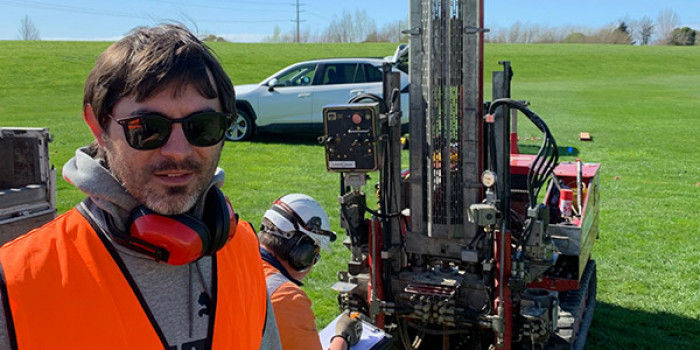Blenheim sites give new understanding of liquefaction in gravelly soil
Prior to the Kaikōura quake it was thought that only sandy soil liquefied, but this study is looking into how the 2016 quake also triggered liquefaction in gravelly soil areas around Blenheim.

Dr Gabriele Chiaro and this team started drilling near Lansdowne Park in Blenheim on Monday to research liquefaction in gravel.
Natural Hazards Commission Toka Tū Ake is funding research to understand how gravelly soil liquefies, and what can be done to minimise the risk.
University of Canterbury’s Dr Gabriele Chiaro will focus on the liquefaction in Blenheim to deliver results that will be of international significance and says the work is crucial to help decision-makers.
“Wellington’s waterfront is on gravelly reclaimed land which liquefied with severe consequences for the port infrastructures. We also had liquefaction in gravelly natural soil deposits in Blenheim, though in this case the extent of damage caused to land and structures was fortunately less severe. We need to better understand why this particular type of soil may also liquefy during strong earthquakes and what can be done to strengthen it so councils, planners and developers can make better-informed decisions about building on this type of land,” he says.
Dr Chiaro says that the effects of liquefaction in gravelly and sandy soils are the same. “When a soil liquefies under earthquake shaking, it behaves more similarly to a liquid than a soil, causing buildings to tilt and sink, underground water and sewerage pipes to deform and burst, and sloping ground to move laterally and spread towards rivers and lakes”.
Natural Hazards Commission Toka Tū Ake’s Dr Jo Horrocks says the project will produce practical results that will help councils around New Zealand decide what type of building could be built on soil of this type, or how the soil could be strengthened.
“It’s part of providing a full picture of the land and soil in a particular location that can be used to reduce the risk to people, households and communities.”
Dr Chiaro says the first phase of the research is to establish exactly which gravelly soil deposits are likely to liquefy.
“The first two sites we’ll be testing are in proximity to Lansdowne Park where we’ll be drilling 15 metres below the ground surface to find out how strong the soil is. We do this by pushing a large steel cone into the ground and measuring how much resistance it provides. We’ve had to have special equipment designed to tests gravelly soils as existing testing devices to date have been developed and used primarily for sandy soil,” says Dr Chiaro.
“We’ll also take soil samples so we can determine the exact size and shape of particles in the liquefaction-prone soil, along with what the mix is of gravel, sand and silt,” he says.
For the second phase of the research, soil samples will be placed into a custom-made laboratory testing apparatus at the University of Canterbury that can replicate the type of earthquake load that can cause liquefaction.
Dr Chiaro says results from the research can be used for improving local hazard maps, and to build a database of gravelly soil susceptible to liquefaction.
“It’s not just useful for New Zealand, we know that other countries are looking at this research with great interest and we expect to be putting out some international guidelines once we have the results.”
Image: Dr Gabriele Chiaro and this team started drilling near Lansdowne Park in Blenheim on Monday to research liquefaction in gravel.
Natural Hazards Commission Toka Tū Ake funds around $17 million of research each year to reduce the impact of natural disaster on people and property. This project is funded through a Natural Hazards Commission Toka Tū Ake Biennial Research Grant.